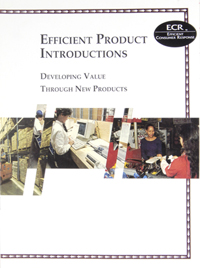- January 4, 2012
- Posted by: tpgstaging
- Category: reports

Price: Complementary
[button size=”medium” color=”black” link=”/order-now-free-publications/”]Order Now[/button]
 The Efficient Product Introductions: Developing Value Through New Products report was authored by The Partnering Group and Ernst and Young working with Category Management Process Improvement Group and other leading retailers and manufacturers in North America. The project was sponsored by the Joint Industry Project on Efficient Consumer Response.
The Efficient Product Introductions: Developing Value Through New Products report was authored by The Partnering Group and Ernst and Young working with Category Management Process Improvement Group and other leading retailers and manufacturers in North America. The project was sponsored by the Joint Industry Project on Efficient Consumer Response.
Developing efficient methods for introducing new items into the supply chain remains one of the least realized opportunities associated with Efficient Consumer Response (ECR). Each year, the average grocery industry distributor may see as many as 20,000 new U.P.C.’s, ranging from minor package changes and bundle packs to truly new products. Efficient Product Introductions (EPI) is a multibillion dollar opportunity that can benefit any and all associated with the grocery supply chain. Finding new models for effective new item development can benefit manufacturers that stand to save significant product development, marketing and promotional expenses; distributors, that face significant costs whenever items are introduced and/or deleted from their systems; and, perhaps most importantly, consumers, whose increasingly busy lifestyles reject long shopping trips and hours spent seeking out just the right SKU.
This report provides both a process and tool kit to help make sure the right new products find their ways to grocery shelves and consumer pantries. There are literally billions of dollars and untold numbers of consumer satisfaction issues associated with this effort. Both the process and tools contained in this report have been created to be consistent with existing industry ECR efforts, especially in the area of category management.
The report explores three components of EPI: common language and measures; a collaborative process; and a common roadmap. Together these three components should enable suppliers and distributors to accomplish four goals: the early identification and elimination of products destined to fail; a method for focusing resources on the best new ideas/products; improving the quality and success of new products coming to market; and finally the facilitation of fact-based EPI decisions among trading partners.
Common language and measures, discussed in Chapter Three, can allow trading partners to agree on such basic issues as what is a new product; how the success of a new product can be measured; and which pre-market measures can best predict a new item’s potential success. Although earlier work in this area drew significant distinctions between new brands, line extensions (new flavors, varieties, sizes, packaging category and subcategory extensions) temporary items and replacement items, this study applies the new product label to any and all of these types of items. Success here is defined as the ability to maintain meaningful distribution in-market for at least two years. But, the real challenge associated with EPI revolves around developing models that help suppliers and distributors to understand which items will succeed before the actual product launch. In this report, five key factors to predicting pre-launch success are discussed: consumer interest in trying a new concept; post-trial consumer acceptance; the quantity and quality of advertising effectiveness in generating awareness of the item; the effectiveness of direct-to-consumer promotion and in-store promotion; and finally the percentage of the new item’s volume that is incremental to the supplier and distributor.
Chapter Four explores how effective, collaborative EPI can be approached by a four-phase process designed to help suppliers and distributors make three key decisions. The first phase is the actual development of a new product. The phase ends with the supplier deciding whether to present the new item to distributors for market introduction. The second phase centers on new product evaluation, the period when the distributor evaluates whether it will accept the new product. This phase includes an Evaluation Scorecard and ends with the distributor’s decision of whether or not to sell the new product to consumers. Phase Three concerns new product planning and implementation, the time when trading partners jointly develop and implement plans to get a new item to consumers. Phase Four addresses new product monitoring and plan modification, or the evaluation of actual in-market performance. The fourth phase leads to the decision, typically made by the distributor, whether to continue or de-list an item. Phases Three and Four include the use of the Performance Scorecard.
Chapters Five through Eight describe each of the four phases of the EPI collaborative process in more detail. Chapter Five is intended to help suppliers develop new items that win for themselves, their trading partners and consumers, and along the way, increase the odds of a new item’s success. During this phase, suppliers construct a fact-based proposal for a new product that will eventually be presented to the distributor community. The steps to developing a successful new product often include preliminary market assessment, cost and technical feasibility studies; concept development and screening; product prototyping; detailed business case development; product and introductory plan development; manufacturing start-up, final product testing and validation; and a final check on market launch readiness.
Phase Two of the collaborative process – new product evaluation – is designed to provide an approach on how distributors and suppliers can jointly evaluate new products. Chapter Six of this report examines how this can be accomplished utilizing the EPI Evaluation Scorecard. The Evaluation Scorecard assists in evaluating a new item from three primary vantages: definition, role and assessment. As used in this scorecard, definition accounts for 15 percent of the new product’s evaluation score and involves the impact that the new product will have on the category’s structure. Does the new product simply fit into the current structure or is it different enough to require a new category or subcategory? Role also accounts for 15 percent of a new product’s score, and involves whether the new product is significant enough to influence the current category role (i.e., destination, routine, convenience). Assessment is by far the most important component of the new product’s score. Assessment helps evaluate the supplier’s pre-market development efforts of the new product based on factors known to be correlated with in-market success. Assessment considers consumer evaluation, market potential, and supplier support for the new product.
The third phase of the collaborative process, new product planning and implementation is the subject of Chapter Seven. Phase Three is essentially concerned with the development and implementation of the introductory marketing plan. Five plan development principles are discussed that center around category building, the level of marketing support for the new item, the financial “payout” of the new item for the distributor, and the level and type of distributor support for the new item. Category strategies and tactics are also examined.
Importantly, Chapter Seven introduces the EPI Performance Scorecard that can play a key role in this phase of the collaborative process. Supplier and distributor trading partners work together to establish the Performance Scorecard in advance of the launch to gain clarity on the requirements for success. Each can then measure progress along the way. The scorecard can consist of consumer, market, financial and productivity / logistics measures. Beyond these measures, the scorecard can include “Time to Payout” or “Time to Break-Even.” “Time to Payout” is defined as the time period over which the distributor should expect to recoup its introductory investment and begin to generate profit from the new product.
Phase Four of the process, new product monitoring and modification, is the topic of Chapter Eight. An approach is provided that can assist supplier and distributor trading partners to jointly evaluate the in-market performance of a new product. Based on the evaluation, trading partners can determine whether or not any modifications need to be made to the initial marketing plan. Once again, the EPI
Performance Scorecard can play a critical role by helping measure results against objectives during this phase.
The final section of the report, Chapter Nine, examines a “common roadmap” to get started with EPI. This chapter describes three basic implementation steps for distributors and suppliers. The first step – Current State Assessment – focuses on understanding existing new product development and introduction capabilities, tools and processes. The second step – Future State Vision and Design – concentrates on establishing the desired future state based on the EPI components outlined in this report. Step three – Pilot and Implementation – centers on testing the solution, refining it, then rolling it out across the organization. It is key during this phase of EPI to remember that people and technology considerations can be as critical as process in determining success. Because so many variables are involved, measurement once again plays a critical role here. And of course, as in any collaborative relationship, there’s no substitute for trust and effective communication.
In the end, EPI can enable both suppliers and distributors to better understand how to increase the success rate of new products and turn their new product introduction processes into a competitive advantage. Simply stated, this report provides a process and tools that industry suppliers and distributors can use to better understand how to increase the success rate of new products and help determine which products deserve to get to shelf.
To obtain a copy of the full report or learn more, contact The Partnering Group email at generalinfo@tpg-mail.com.
